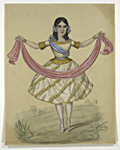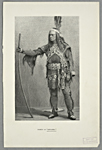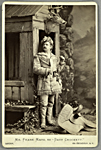Travel by Water and Road
"OCEANA: High on a craggy rock an Indian stood, with sinewy arm and eye that pierced the glen.… With awe I gazed as on the cliff he turned -- the grandest model of a mighty man.…
WALTER: 'Tis Metamora, the noble sachem of a valiant race -- the white man's dread, the Wampanoag's hope." — John Augustus Stone, Metamora (1829) Act I, sc. 1
At the beginning of the 19th century, the performing
arts were flourishing in the new nation. Still, even the thriving
seaports could not support full seasons for commercial theaters
and concert halls. To find sufficient work, performers traveled to
their audiences, commuting between inland and coastal cities,
moving up and down the Eastern seacoast, and eventually, as
transportation methods improved, heading West. Theaters such as
Niblo's Gardens in New York or the Howard Athenaeum in Boston
imported European family troupes of performers. Actor-managers Sol
Smith and Noah Ludlow established a chain of theaters first along
the Mississippi and, later, the Ohio and Missouri rivers. In
addition to actors, these circuits featured ballet dancers, slack-
and tightrope walkers, and jugglers and acrobats, who appealed to
both English-speaking and non-English-speaking audiences.
Touring actors sought vehicles that provided dramatic situations,
rousing speeches, a variety of character parts for their
companies, and starring roles for themselves. That search
eventually struck on the nation's own great conflict -- the ongoing
hostilities between Native Americans and settlers. When
actor-manager Edwin Forrest sponsored a competition for "the
best tragedy, in five acts, of which the hero, or principal
character, shall be an aboriginal of this country," the
winner was John Augustus Stone's Metamora; or, The Last of the
Wampanoags (1829). In 1843, Boston's National Theater billed
L. H. Medina's dramatization of Robert Montgomery Bird's
virulently anti-native novel Nick of the Woods, or The
Jibbenainosay as "Grand National Drama." Female
performers trained in ballet or pantomime were often cast as the
title characters in dramas about Native American women who
sacrificed themselves for their people. John Baldwin Buckstone's
The Green Bushes (1851) and various dramatizations of James
Fenimore Cooper's 1829 The Wept of Wish-ton-Wish were
popular touring vehicles throughout the United States and England.
Such plays constituted the American equivalent of the nationalist
operas and ballets popular in European theaters.
The typical stock characters to appear on stage were the comic
Yankee peddler and the boastful frontiersman; actors Joseph
Jefferson, as Rip Van Winkle, and Frank Mayo, as Davy Crockett,
interpreted these roles for decades.
Refer to Map of the United
States and Mexico (1859), which
details explorers' trails, transportation routes,
settlement patterns, and locations of mineral wealth.
These factors greatly affected tours undertaken by
performing artists in America during the first half of
the 19th century.





